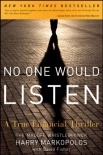No One Would Listen: A True Financial Thriller, Harry Markopolos [graded readers .TXT] 📗

- Author: Harry Markopolos
Book online «No One Would Listen: A True Financial Thriller, Harry Markopolos [graded readers .TXT] 📗». Author Harry Markopolos
I never got a response from the SEC for this second submission, either. It wasn’t until September 2009 that I finally found out what had happened to it. David Kotz, the SEC inspector general, who was charged with trying to figure out why the agency had proved to be completely dysfunctional, reported, “Although this time the BDO did refer Markopolos’ complaint, NERO decided not to investigate the complaint one day after receiving it. The matter was assigned to an Assistant Regional Director in Enforcement for the initial inquiry, who reviewed the complaint, determined that Madoff was not registered as an investment advisor and the next day sent an e-mail stating, ‘I don’t think we should pursue this matter further.’ The OIG could find no explanation for why Markopolos’ complaint, which the Enforcement Attorney and the former head of NERO acknowledged was ‘more detailed than the average complaint’ was disregarded so quickly.”
Of course, I didn’t know any of that. I was still suffering under the delusion that the SEC was a reasonably competent agency that actually served some purpose. So we just kept going.
Like Ocrant, we were beginning to believe that our original estimates of the size of Madoff’s fraud were low, maybe very low. He was voracious, sucking up hundreds of millions of dollars from feeder funds around the world—many of whom did not even know about the others. Every couple of months we were identifying another fund that was feeding cash to him. Madoff just kept growing. Originally we had him at $3 billion; then it was $7 billion. It was getting beyond absurd. I’d get a phone call from Frank, who’d tell me, “You’re not going to believe this, but it’s $8 billion and guess who has him?”
Before receiving that fax in early March identifying Fairfield Greenwich’s Sentry Fund, for example, I had never heard of it. So I had no way of knowing that this fund, which basically did nothing more than hand over its then $3.3 billion portfolio to Madoff, charging a fee to investors of 1 percent of the assets it was managing and 20 percent of the profits it reported, was Madoff’s biggest American client. Biggest American client. It’s doubtful anyone will know how much the European and Asian funds had invested with him, as we were to learn there were some pretty important reasons many Europeans never admitted they had money with Madoff. But in the material I received, Fairfield boasted that the fund had lost money in only four of 139 consecutive months. This was arguably the most extraordinary winning streak in Wall Street history: In almost 12 years of running a market-sensitive strategy, Fairfield claimed to have suffered losses in only four months. And somehow investors believed that!
By now Neil and I were used to reading these astonishing claims. Whenever we got another one in, Neil would look at it and shake his head. “Wow,” he’d say, the sarcasm dripping from his words. “Bernie is amazing. Bernie is the best.”
The few pages I got basically duplicated what we’d seen previously—“We’re handing your money to a manager who will use a ‘split-strike strategy’ and make whatever investment decisions he chooses”—although they were very careful never to specifically identify Bernie Madoff. When I went to the Fairfield Greenwich web site I was immediately struck by its extensive claims about how the firm protected its investors’ money: “The nature of FGG’s manager transparency model employs a significantly higher level of due diligence work than that typically performed by most fund of funds and consulting firms. This model requires a thorough understanding of a manager’s business, staff, operational practices, and infrastructure.”
When Mike Ocrant got this material as part of his investigation, he decided to have his experts crunch the numbers. The MARHedge database included historical hedge fund returns that could be analyzed using proprietary software that could compare the Fairfield returns to the returns of all other hedge funds in the database, as well as to those of hedge funds using the same or different strategies. It could slice and dice the Fairfield numbers to provide a great amount of information. This historical comparison concluded that not only was Madoff the largest hedge fund in existence, but on a risk-adjusted basis it was one of the best-performing hedge funds in history. What it didn’t tell Ocrant—what it wasn’t programmed to find—was that the numbers were fictitious.
Mike called Frank when he got the analysis with the results. “It’s amazing,” he told him. “This guy has got beyond astounding returns for a guy we’ve never heard of.”
Ocrant went further. At an Association of Financial Engineers conference he had heard a lecture by Andrew Weisman, who was then the chief investment officer and a board member at Nikko Securities, where he oversaw that firm’s hedge fund of funds operation, and was generally considered one of the real experts in hedge funds. He called Weisman and asked him to take a look at a return stream to see if it made sense. He sent him only the raw data, removing any references that would have allowed anyone to identify Fairfield or Madoff.
Weisman called him about a week later. He’d asked his team to do some reverse engineering, he explained, then said, “This could be done. You could get this kind of return stream if you were a market maker.” Then





Comments (0)